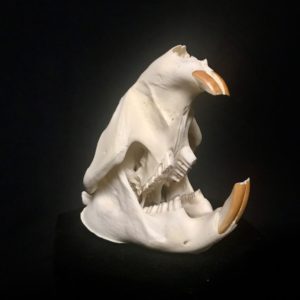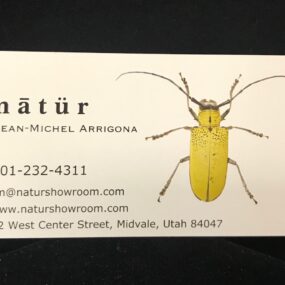Description
Incredible Gaboon viper skull, mounted in a 5.5 X 5.5 glass dome. This is an amazing specimen.
Gaboon vipers are the largest vipers in Africa, weighing up to 45 pounds and reaching lengths of more than 6 feet. The largest specimens have heads that are nearly 6 inches across at their widest point.
Gaboon vipers have a fairly mellow nature and very rarely bite humans. Most bites occur when the snake is stepped on. If harassed, the Gaboon viper will raise the upper part of its body and hiss before actually striking. In addition to its unwillingness to bite, the viper can control whether it injects venom and how much, so the result of a strike can range from no effect to rapid death.
Gaboon vipers can live up to 20 years.
The Gaboon viper (Bitis gabonica) is one of the most remarkable and awe-inspiring snakes in the world, known for its impressive size, stunning appearance, and powerful venom. Here’s everything you need to know about this incredible reptile:
1. Stunning Appearance
The Gaboon viper is a visually striking snake with a large, broad head and beautifully patterned scales. Its color palette consists of rich shades of brown, orange, and pink, blending with intricate geometric patterns that help it blend seamlessly into the forest floor or leaf litter of its African habitat. The viper’s large, triangular head is adorned with two fleshy “horns” on the snout, which give it a unique, almost mythical look.
2. Size and Strength
The Gaboon viper is one of the largest vipers in the world, with some individuals growing up to 6 feet (1.8 meters) in length. Despite its massive size, it has a relatively slow and calm demeanor, which contrasts with its lethal capabilities. It is known for its powerful strike, which can be delivered in a fraction of a second, striking with remarkable precision and force.
3. Deadly Venom
The venom of the Gaboon viper is a mixture of hemotoxins (which affect blood and tissues) and neurotoxins (which affect the nervous system). While it is not particularly aggressive, a bite from this snake can be fatal if not treated promptly. However, bites are rare because the snake is generally non-confrontational, preferring to remain still and rely on its camouflage to avoid detection.
- Venom Composition: The venom is potent enough to immobilize or kill prey such as rodents, birds, and amphibians, but it is generally used for hunting rather than defense.
- Amount of Venom: A single bite can inject enough venom to kill multiple large animals. Fortunately, the Gaboon viper is slow to act and often gives prey a fatal dose of venom, which can take time to work.
4. Stealth and Hunting Style
The Gaboon viper is an ambush predator, using its camouflage to remain motionless for long periods while waiting for prey to come close. When prey—such as small mammals, amphibians, or birds—comes within striking distance, the snake delivers a lightning-fast strike. Its strike is not only powerful but precise, often taking prey by surprise.
- Feeding: Once it strikes, the venom works quickly to paralyze or kill the prey. The snake then swallows its catch whole. The Gaboon viper can go for weeks between meals, as it can eat large prey relative to its size.
5. Behavior and Habitat
The Gaboon viper is native to sub-Saharan Africa, and its range extends from West Africa to Central Africa. It prefers rainforests, savannas, and forest edges, often inhabiting areas with dense vegetation and leaf litter where it can remain well camouflaged.
- Nocturnal: It is mostly nocturnal, coming out to hunt at night when the temperatures are cooler.
- Territorial: While not overly aggressive, it will defend itself if threatened. It relies on its camouflage to avoid confrontation, but when disturbed, it may hiss loudly and flatten its body to appear larger, or strike if provoked.
6. Reproduction
Gaboon vipers are ovoviviparous, meaning they give birth to live young (as opposed to laying eggs). A single clutch can contain up to 40 babies, each equipped with their own venom, which helps them hunt immediately after birth.
7. Conservation Status
The Gaboon viper is not currently listed as endangered, but its populations are threatened by habitat destruction and the illegal pet trade. In some areas, it is hunted for its skin or for the exotic pet market.
8. Interesting Facts
- The horns on its nose are thought to help with camouflage, mimicking the appearance of dry leaves or twigs.
- Despite its fearsome reputation, the Gaboon viper is not aggressive and would rather remain hidden than attack. It’s considered one of the least likely venomous snakes to bite humans.
- Their slow metabolism and long fasting periods make them one of the more efficient hunters in the reptile world.
9. In Captivity
In captivity, the Gaboon viper requires specialized care. It needs a large enclosure with sufficient space, appropriate temperature, humidity, and a variety of hiding spots to mimic its natural environment. While fascinating to observe, it’s not recommended for novice snake owners due to its venomous nature and the expertise required to care for such a species safely.
The Gaboon viper is a master of disguise and a powerful predator, showcasing the elegance and danger that nature has perfected over millions of years. Its remarkable appearance and deadly efficiency make it one of the most incredible snakes in the world.






















